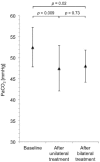Endoscopic lung volume reduction coil treatment in patients with chronic hypercapnic respiratory failure: an observational study
- PMID: 27784816
- PMCID: PMC5941978
- DOI: 10.1177/1753465816676222
Endoscopic lung volume reduction coil treatment in patients with chronic hypercapnic respiratory failure: an observational study
Abstract
Background: Endoscopic lung volume reduction coil (LVRC) treatment is an option for selected patients with severe emphysema. In the advanced stages, emphysema leads to respiratory failure: hypoxemia and eventually chronic hypercapnic respiratory failure. It can be hypothesized that LVRC treatment, a procedure targeting hyperinflation and thereby reducing ventilatory workload, may be especially beneficial in patients with chronic hypercapnic respiratory failure. This study was conducted to gain first insights into the effects and the safety of LVRC treatment in patients with emphysema and chronic hypercapnic respiratory failure.
Methods: A retrospective observational study conducted in the Department of Respiratory Medicine at the University Medical Center Hamburg-Eppendorf, Germany on all patients with chronic hypercapnic respiratory failure in whom bilateral LVRC treatment was performed between 1 April 2012 and 30 September 2015.
Results: During the study period, bilateral LVRC treatment was performed in 10 patients with chronic hypercapnic respiratory failure. Compared with baseline, bilateral LVRC treatment led to a significant increase in mean forced expiratory volume in one second (FEV1) from 0.5 ± 0.1 l to 0.6 ± 0.2 l ( p = 0.004), a decrease in residual volume (RV) from 6.1 ± 0.9 l to 5.6 ± 1.1 l ( p = 0.02) and a reduction in partial pressure of carbon dioxide in arterial blood (PaCO2) from 53 ± 5 mmHg to 48 ± 4 mmHg ( p = 0.03). One case of hemoptysis requiring readmission to hospital was the only severe adverse event.
Conclusions: LVRC treatment was safe and effective in patients with nonsevere chronic hypercapnic respiratory failure. It led not only to an improvement in lung function but also to a significant decrease in PaCO2.
Keywords: chronic hypercapnic respiratory failure; emphysema; endoscopic lung volume reduction; endoscopic lung volume reduction coil; interventional pulmonology.
Conflict of interest statement
Figures




References
-
- Albert R., Benditt J., Hildebrandt J., Wood D., Hlastala M. (1998) Lung volume reduction surgery has variable effects on blood gases in patients with emphysema. Am J Respir Crit Care Med 158: 71–76. - PubMed
-
- Argenziano M., Moazami N., Thomashow B., Jellen P., Gorenstein L., Rose E., et al. (1996) Extended indications for lung volume reduction surgery in advanced emphysema. Ann Thorac Surg 62: 1588–1597. - PubMed
-
- ATS Committee on Proficiency Standards for Clinical Pulmonary Function Laboratories. (2002) ATS statement: guidelines for the six-minute walk test. Am J Respir Crit Care Med 166: 111–117. - PubMed
-
- Bierach J., Maloney J., Ferguson J. (2013) Endobronchial valve placement for a giant bulla in a patient with hypercapnic respiratory failure. Ann Am Thorac Soc 10: 521–524. - PubMed
-
- Budweiser S., Heinemann F., Meyer K., Wild P., Pfeifer M. (2006) Weight gain in cachectic COPD patients receiving noninvasive positive-pressure ventilation. Respir Care 51: 126–132. - PubMed
Publication types
MeSH terms
Substances
LinkOut - more resources
Full Text Sources
Other Literature Sources
Medical
Miscellaneous

